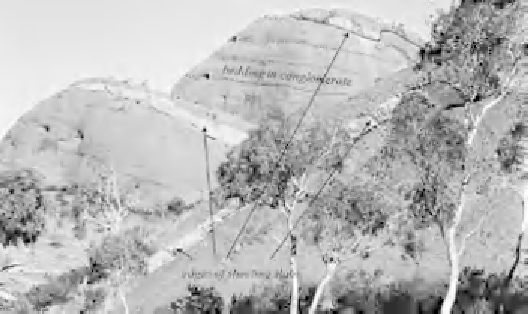Geology Reference
In-Depth Information
Figure 3.45
Sheeting joints
through
conglomerate. Kata
Tju
t
a (the Olgas),
Australia.
unfractured rock. Holzhausen (1989) describes propagation of new
sheeting joints under a horizontal stress of about 17 MPa at a depth of
only 4m, where the vertical con
ning stress due to self-weight of the
rock is only about 100kPa. The mechanism is similar to a uniaxial
compressive strength test where tensile fracture propagates parallel to
the maximum principal stress (
1
). Such exfoliation and tensile devel-
opment of sheeting joints is analogous to the sometimes explosive
spalling and slabbing often seen in deep mines (Hoek, 1968;
Diederichs, 2003).
From a worldwide perspective, however, the joints most commonly
recognised as sheeting structures are observed in steep natural slopes.
These joints are also thought to develop as tensile fractures where the
maximum compressive stress due to gravity is reoriented to run paral-
lel to the slope, as demonstrated by numerical models (Yu & Coates,
1970; Selby, 1993) and discussed in detail by Bahat et al. (1999).
Sheeting joints also develop parallel to the stress trajectories that
curve under valleys where there has been rapid glacial unloading or
valley downcutting. Failure and erosion is a continuing process, with
the formation of new sheeting joints following the failure of sheet-
bounded slabs. Wakasa et al. (2006) calculated an average erosion rate
of 56m in one million years from measurements of exposed sheeting
joints in granite in Korea (
Figure 3.46),
which is signi
σ
cantly higher
than erosion rates on other slopes without sheeting joints. Whilst many
exposed sheeting joints are evidently very recent, others are much
older. Jahns (1943) and Martel (2006) note the apparent dissection
of landscapes post-dating sheet joint formation. Antiquity is also
sometimes indicated by degree of weathering. Additional evidence
for the great age of some sheeting joints is the fact that they can
sometimes be observed cutting through otherwise highly fractured
rock. Most sheeting joints occur in massive strong rock and it is
argued that if the rock mass had been already highly fractured or
weathered then the topographic stresses would be accommodated by

